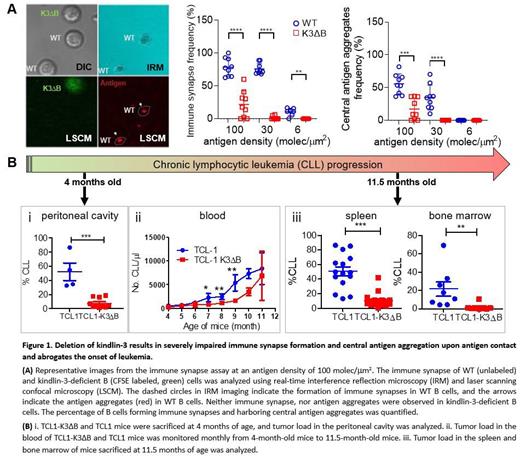Background:
High affinity antibody production occurs in the germinal centers (GCs), which are segregated into a dark zone (DZ) and a light zone (LZ). GC B cells proliferate in the DZ and encounter follicular dendritic cells in the LZ. Cell trafficking between the two zones is regulated by CXCR4 (DZ) and CXCR5 (LZ) signaling. Integrins may regulate B cell positioning and B cell immune synapse formation. Recently, we have shown that the integrin adaptor kindlin-3 is not only required for integrin activation in B cells, but unexpectedly also acts as a brake on CXCR5 responsiveness. Kindlin-3 thereby prevents B cell hyperactivation and differentiation into GC-like B cells in absence of antigen. 1 Here we investigate the impact of kindlin-3 on GC responses upon antigen challenging and on malignant transformation.
Methods:
We developed a B cell-specific knockout mouse model (mb1Cre Fermt3fl/fl (K3ΔB)) in which kindlin-3 ( Fermt3) was knocked out in all B cells. K3ΔB and control wild-type (WT) mice were challenged with sheep red blood cells (SRBC). GC formation and immunoglobulin (Ig) production were analyzed by flow cytometry. Ex vivo B cell proliferation and Ig class switching formation assays were performed. We investigated the immune synapse formation of WT and kindlin-3-deficient B cells using a biomimetic model involving a planar artificial lipid bilayer containing GPI-linked integrin ligands and bound fluorescently labeled surrogate antigens. The formation of immune synapse and central antigen aggregation in the immune synapse were analyzed by real-time interference reflection microscopy and laser scanning confocal microscopy. To investigate the contribution of kindlin-3 in a model of mature B cell malignancy, we used TCL1 transgenic (TCL1) mice resembling chronic lymphocytic leukemia (CLL) to generate the mb1Cre Fermt3fl/fl Tcl1 (TCL1-K3ΔB) mouse model. Tumor burden in TCL1-K3ΔB and TCL1 control mice was monitored by flow cytometry over time and at sacrifice using CD19/CD5 antibodies. B cell receptor (BCR) signaling of CLL cells was analyzed using Phosphoflow.
Results:
K3∆B mice immunized with SRBC exhibited defective GC responses (30% reduction in GC-B cells compared to WT) and antibody production (49% reduction in SRBC-specific IgG2b production in serum compared to WT) on day 7 after immunization. Ex vivo, kindlin-3-deficient B cells were unable to form immune synapses (Figure 1A), to proliferate, and to switch antibody classes. The tumors in TCL1 mice started in the peritoneal cavity and subsequently spread to the spleen, blood and bone marrow. TCL1-K3ΔB mice presented with an almost complete abolished leukemia onset in the peritoneal cavity (92% less tumor burden in TCL1-K3ΔB compared to control TCL1 mice) in 4-month-old mice (Figure 1B i). Moreover, tumor burden in blood (Figure 1B ii), spleen, and bone marrow (Figure 1B iii) was strongly reduced at the late stage of disease (11.5-month-old mice), with an 82% lower tumor burden in spleen and a 90% lower tumor burden in bone marrow of TCL1-K3ΔB mice compared to TCL1 control mice. In addition, kindlin-3-deficient CLL cells exhibited impaired phosphoAkt and phosphoSyk signaling upon BCR engagement.
Summary/Conclusion:
In summary, kindlin-3 maintains the balance between a state of B cell homeostasis and an effective antigenic response by acting as a gatekeeper of GC formation, and is substantial for leukemic onset in CLL.
Reference:
1. Härzschel A, Li L, Krenn PW, et al. Kindlin-3 maintains marginal zone B cells but confines follicular B cell activation and differentiation. J Leukoc Biol. 2022 Apr;111(4):745-758.
Disclosures
Polcik:AstraZeneca: Research Funding. Hartmann:AstraZeneca: Research Funding.


This feature is available to Subscribers Only
Sign In or Create an Account Close Modal